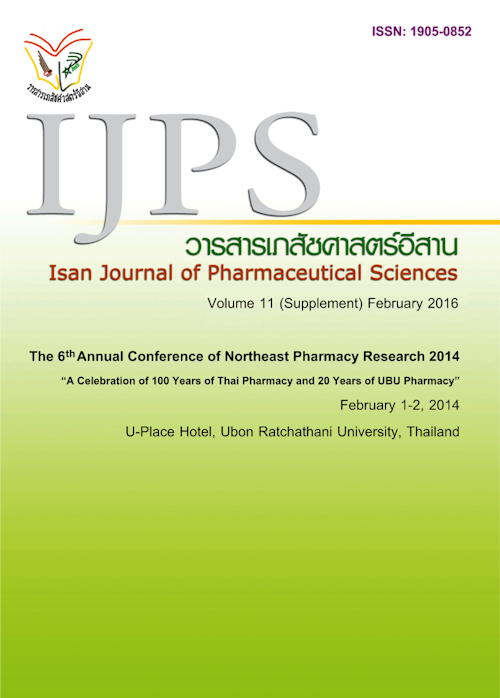A Survey of Marketing Data and Developing Marketing Plan of Herbal Medicines for “U_Medical” Faculty of Pharmaceutical Science, Ubon Ratchathani University
Main Article Content
Abstract
Introduction: Herbal medicine has been currently accepted as an alternative treatment. Faculty of Pharmaceutical Sciences Ubonratchathani University has established a unit of herbal medicine production named “U_medical” aimed to research and develop herbal products to the market. This research aimed to study the situation of herbal medicine marketing and to develop marketing plan for “U_medical”. Materials and Method: Questionnaire was mailed to pharmacists in 29 hospitals in Ubonratchathani and nearby provinces. In-depth interview was used to collect data from 12 pharmacists in hospitals and drug stores. Descriptive statistics and SWOT analysis were used. The marketing plan was developed. Results: Curcuma (86.2%) and Fathalaichon (86.2%) single herbal medicine ranked in the highest utilization in hospitals (86.2%), Prasamawaeng was ranked in the highest of mixed formula herbal medicines (30.8%).The herbal medicines mostly prescribed by medical doctors and Thai traditional doctors. The main herbal medicines suppliers for hospitals were the production units of hospitals within the province (80.8%), GPO (42.3%), and private companies(38.5%). The criteria of purchasing were GMP certificate (65.5%), registed drug approved by FDA (51.7%). The main problem of herbal medicines order is a lag time from herbal material insufficiency. A main problem in herbal product was the concern about its efficiency and price which was higher than modern medicines. The strengths of U_medical herbal product are quality of production and the competitive price. The weaknesses are low capacity in production and no marketing plan. Opportunity of herbal medicines come from the National Essential Drug List policy. Threat is the high competition in the market. The marketing plan about the herbal product of “U_medical” composed of; setting the marketing target to hospital physicians and community pharmacists, maintaining the high standard of production, setting rational price, distributing to hospitals and drug stores and developing marketing promotion to the target groups. Conclusion: Single herbal medicines in the National Essential Drug List are common used. The marketing plan should focus on standard of production process, the target groups and marketing promotion in both government hospitals and drug stores.
Article Details
In the case that some parts are used by others The author must Confirm that obtaining permission to use some of the original authors. And must attach evidence That the permission has been included
References
Bureau of Drug Control. Product value and Imports of traditional medicine since 2010-2012 [Internet]. [cited 2012 Dec 28]. Available from: http://www.fda.moph.go.th
Chirunthorn R, Singpaiboonporn N, Ngaodulyawat P, et al. Factor Affecting on Decision Making on Purchasing of Dietary Supplement case study of Hat Yai District, Songkhla Province. Songkhla: Prince of Songkhla University; 2007
Khaporn N, Thosajheon K, Thaworachareonsup M, et al. View of Health Professionals on Herbal Medicine and Policy for Promotion of Herbal Medicine Use in Healthcare Settings: Health Intervention and Technology Asessment Program. 2010; 3-11
Wiboonpon S, Petrakart P. Knowledge and Management. Thai wisdom: the way of thai health. Bangkok: 2007


